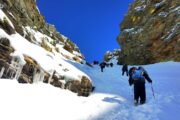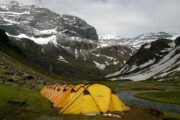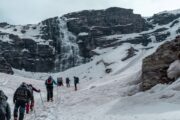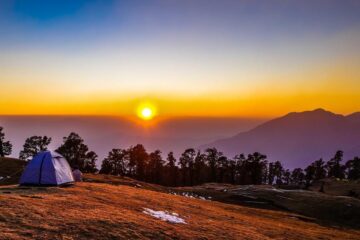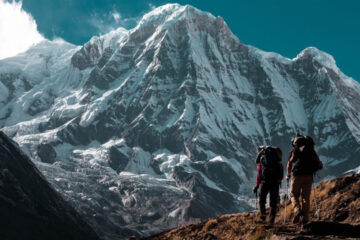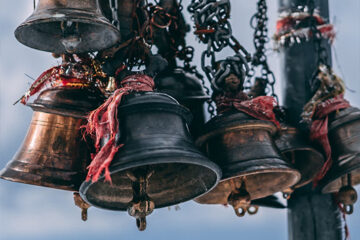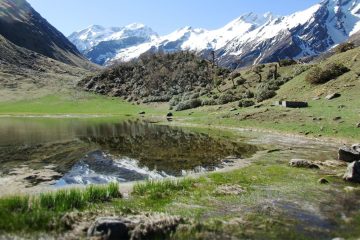The Rupin Pass Trek
Region :- Uttarakhand
Snow: December to March
The Rupin Pass trek is a glacial crossover from the nation of Uttarakhand to Himachal Pradesh. The trek starts off with a force from Dehradun to Dhaula, which is a 130km long adventure through avenues and ends at Sangla village in Himachal Pradesh. Dhaula is situated at an altitude of 5,100 ft. The Rupin Pass trek boasts a max altitude of 15,300 ft. This is a significant advantage in altitude, and trekkers will want to be prepared for this easy-to-moderate grade trek, as trekkers will have to cover approximately 10km per day.
Rupin Pass is one of the most enjoyable treks due to the variety of scenery and unexpected changes along the way. At one point, you are probably mountaineering a steep path, which might unexpectedly turn into a smooth walk.
The trek is full of surprises at each step, which incorporates the Jhaka Village, additionally called the striking village. The particular role of the village on the brink of the mountain makes it look like the village is striking through the cliff. Apart from this, you’ll come across some snow bridges, deep dark forests of fir, oak and rhododendron, waterfalls that seem to be falling from the sky, and the view of majestic Kinner Kailash on the cease of the Rupin Pass Trek will actually leave you spellbound.
Trek Highlights
One of the most stunning campgrounds in the Himalayas is the lower waterfall camping. It’s tucked at the bottom of a perfect “U” shaped glacier valley, on the bed of a lush green meadow. From your vantage point at the bottom of the meadow, snow-covered cliffs loom on all three sides.
The Rupin gully is a mountainside half-tube. The near-vertical ascent is enough to make your heart stop when you first see it from the trail.
The trail drops abruptly from the snowline following the pass, through boundless meadows that reach all the way to Sangla Kanda. In the midst of these meadows is the Ronti Gad campground. A thriving creek rushes alongside the campsite, which is surrounded by towering, snow-capped mountains
The Rupin Pass, at 4,650 meters above sea level, is a moderate-level walk appropriate for hikers who have already completed an easy hike and want to challenge themselves. Although the daily distances covered are fair and the height rise on the trek is consistent, the trail does present some challenges that necessitate a special set of abilities to successfully manage its environment. Rupin Pass is best hiked in the months of May and June, as well as September and October. Not only does the landscape alter, but everything else does as well. The Rupin River takes on various forms as we walk from campsite to campsite. If we had to pick a favorite feature of the trek, this would be it. It is unique in that you can trek from the riverbank in Dhaula all the way to the top of the Rupin Waterfall. Few people can say they’ve followed a river’s path as closely as the Rupin Pass Trek!
Day 1: Arrival at Batwa
• Drive 195 km takes 8-9 hrs
• Altitude 2,350/7,700 feet
Day 2: Bawta to Jakha
• Altitude 2,750m/ 9,000ft
• Trek 5 km, 4 hrs
• Altitude Gain: 400m/1,300ft
• Difficult level of ascent, steep climb
• Moderate ascent till Jiskun then descent till wooden bridge through forest and then zig-zag ascent till Jakha
• Highest and the last village of Rupin pass trek
• Selwan Khad is the last water point
• Tea and maggi shops are on the way
• BSNL network is available
• Hot lunch at camp site
• Stay in home stay
Day 3 : Jakha to Dandreyash Thatch
• Altitude Gain:800m/2,700ft
• Easy but long walk . Most of the walk is along with the river
• Can refill water bottles from the river
• Enjoy the snow bridges and wild flowers
• Trail surrounded by Silver birches (Bhoj trees), Rhododendrons (white, pink, purple)
• Packed lunch will be given
• Stay in tent
Day 4: Dandreyash Thatch to Upper Waterfall
• Trek:5 km, 3-4 hrs
• Can refill water from small streams . Most scenic day of the trek
• Moderate level of ascent, continuously tricky climbing trail around the snow patches
• Avoid getting on the snow patch directly
• Meet the technical team they will give you important tips for the summit day
• Hot lunch at campsite
Day 5: Upper Waterfall to Ronti Gad
• Difficult Level of ascent. Longest and most exciting day of the trek
• Steep ascent till the pass and then steep descend
• 200 mtrs of very steep ascent known as Rupin Gully, just before the pass, give pass to porters and guides, let them go ahead
• Leave camp site by 4:30 am
• Carry enough hot water from the camp site, Water sources are limited
• Packed lunch will be given
• Reached Ronti gad late in the evening.
Day 6: Rest / Acclimatization
• Will be used as a rest, acclimatization or buffer day
• This day can be used at any camp, depends on trekker’s fitness and weather
• In general we use this day at Dandreyash Thatch camp
Day 7: Ronti gad to Sangla & Drive to Shimla
• Trek: 8 km, 4-5 hrs . 9-10hrs drive to Shimla
• Moderate level of descent, continuously descent till Sangla
• Many water taps on the way
• Reach Sangla 1-2 pm
• Cab leaves from Sangla at 3 pm and reached Shimla by 1 am
Day 1- Arrival at Batwa
The journey will take around 8 hours to complete, with comfortable stops for lunches along the way. After arriving, take in the Himalayan sunset and a delectable dinner before retiring to your tent for the night.
Day 2- Bawta to Jakha
Today you will pass through the trek’s highest and final settlement. In addition, the course will consist of a continuous uphill for 4-5 hours. So, before you go on the zig-zag mixed trail, take in all of your energy. There will be a minor descent trail after a moderate ascent to Jiskun. A wooden bridge can be found amid the deep woodland. From the bridge, the path begins to ascend in a zig-zag pattern. This is the last water stop for the day, so refill your bottles at Selwan Khad. Don’t worry, there are plenty of tea shops along the way if you run out of water. At night, relax in your lovely house.
Day 3- Jakha to Dandreyash Thatch
It’s pure delight to wake up at the campsite near Jhaka Village. The trail is well-marked, goes through Jhaka village’s field, then enters a forest with tall fir trees, evoking centuries of immaculate civilization. The trail changes to snow patches after passing through the forest and vistas. Follow the snow bridge over Rupin, cross the bridge, and continue walking along a narrow track until you reach another wooden bridge.After a half-hour hike on the stones and via the streams that flow through the stony trails to Rupin’s left, you’ll reach another forest with different-colored Rhododendron trees. You’ll arrive at Saruwas Thatch after a short stroll of a few kilometers. Relax and enjoy the various shades of nature on the ideal campground, a tranquil u-shaped valley in the center of woods with a distant view of Rupin waterfall.
Day 4- Dandreyash Thatch to Upper Waterfall
We’ll take the required efforts to avoid any complications with altitude. Our staff will also conduct a brief training session to teach you the fundamentals of snow trekking, such as sliding, sidestepping, and cutting through the snow. After sufficient acclimatization, travel to the base of the Dhanderas, crossing various rivulets of Rupin on the way. Through the marigold flowers, make your way to the first waterfall’s snow patch. Following a slow and careful stroll around the ledges of the slope, you can now see a track cutting through the deep snow. Your newly acquired skills will come in when you need to clear a way to another massive snow bridge. This is the final but most spectacular snow bridge, with the Rupin Water flowing barely above your head and down below your feet. After a short but steep climb after crossing the bridge, you’ll be ready to relax and enjoy your campground.
Day 5- Upper Waterfall to Ronti Gad
Rupin Pass’s longest trek begins with a hard rise and a significant elevation gain. After an hour of climbing, turn left and experience completely new and spectacular sights from the Rati Pheri campground.
The only views from Rati Pheri are of a vast area of thick snow, and navigating your way through it will be your next laborious effort for the day in order to reach Rupin Pass Gully. We’ll take extra precautions here because the snow is really deep and the trails aren’t well-defined. We’ll serve you some refreshments at Rupin Pass to help you refuel for the next challenging climb to Rupin Pass. The trail to Rupin Pass is short but treacherous, with loose stones falling from the sky. Our team recommends that you carefully stroll in line, putting your best foot forward.
Day 6- Rest / Acclimatization
This is a critical day in the climb since it considerably increases the possibilities of reaching the summit, and it must not be overlooked. Depending on the conditions at the time, this day can be used in any camp during the route. Many times it has been seen that trekkers become fatigued or the weather does not cooperate, necessitating a one-day rest, and due to a shortage of time, completing the journey becomes difficult. At that time, this day comes in handy and prevents our plans from being wrecked.
Day 7- Ronti gad to Sangla & Drive to Shimla
Today’s hike will be a downhill ascent, but one that will be quite difficult due to the trail’s quick descent in altitude. Our crew will perform another fight to help you adjust to the acute descent, allowing you to climb down with greater ease and without injuring your foot or knees.
By Air:-
Dehradun’s Jolly Grant Airport is located about 20 km from the city. You will find a daily flight from Delhi to Dehradun.
Taking the train:
Take the overnight train to Dehradun from Delhi.
- Nandadevi Express-Departure at 11:50pm; Arrival at 5:40am
- Dehradun Express-Departure-9:10pm; Arrival-5:00am
By Bus:-
From Delhi’s ISBT Kashmere Gate, a regular bus service from Delhi to Dehradun is available.
includes
- Meals during the trek
- Dinner on arrival day in Sankri.
- Forest Permits/Camping Charges (only if availing transportation through A1 Himalayas). Only up to the amount charged for Indian Nationals is included.
- Tents, sleeping bags, mats
- Safety equipment includes static rescue rope, seat harness, carabiners, pulleys,
- Trek guide, cook, helpers, porters, & mules for carrying common luggage.
- The Services of a Certified Trek Leader
excludes
- Meals during road journeys
- Transportation from Dehradun to Sankri and back to Dehradun.
- Carriage of personal bags during the trek
- Any kind of insurance
- Any expense of a personal nature.
- Any expense not specified in the inclusion list
1) Trekking Shoe/Snow Shoe
2) Rucksack/Back Pack
3) Rucksack cover (Waterproof)
4) Daypack/Knapsack
5) Undergarments/Innerwear
6)Woolen socks
7) Woolen gloves
8) Waterproof gloves
9) T-shirt
10) Trek pants
11) Camp sandal
12) Balaclava/Woolen skull
cap/Monkey Cap
13) Sun cap/Wide-brimmed
Hat/Bandana
14) Walking Sticks/Trekking
Poles/Ski Poles
15) Heavy Jacket
16) Windproof Jacket/Wind
Cheater
17)Raingear/Poncho/Waterproof clothing
18) Water bottle/Hydration pack
19) Sunscreen lotion
20) Sunglasses
21) ChapStick/Cold &
Moisturizing cream
22) Toothbrush and toothpaste
23) Towel
24) Hand sanitizer
25) Tissue roll ( Toilet)
26) Anti Fungal Powder
27) Torch/Head Lamp with extra batteries
28) Knee cap
29) Camera with extra cells
30) Dry food items
31) Personal first-aid kit
32) Medicines (This is a simple
guide line and a doctor’s
consultation is recommended.)
Altitude is a risk. Before you begin the trek, you should be aware of the effects of high altitude on your body. Acute Mountain Sickness (AMS) symptoms include a moderate headache, nausea, and overall discomfort.
Reponse: If you have any of these symptoms, notify the trek leader immediately and follow his advice. To deal with the scenario, each campsite contains a stretcher, a fully prepared first aid kit, and oxygen cylinders.
Weather Risk : No one can guarantee snow, rain, or sunlight, even if we keep a constant eye on the weather. Please keep in mind that your safety is our primary priority, and if the weather isn’t cooperating, we won’t leave the campsite.
Response: The choice to go or wait for better weather will be made solely by the Trek Leaders and Guides.
Risk: Injury is a possibility. While trekking across difficult terrains, minor injuries such as calf sprains, bruising, and other minor ailments are prevalent. Serious injuries, such as fractures or significant cuts, are quite uncommon.
Response: All of our Trek Leaders are trained in wilderness first aid. They’ve been taught to deal with emergencies and have a well-stocked first-aid equipment to deal with minor injuries. In the event of major injuries, the patient is carried to the nearest road-head on a stretcher and taken to the nearest medical facility.
DO’S AND DON’TS ON A TREK
1. Alcohols or any other intoxicating products ‘’STRICTLY PROHIBHITED’’
during the trek.
2. Always pay heed to the trek guides or instructors.
3. Try not to leave the group under any circumstances.
4. Avoid trekking during the nights as it is extremely dangerous.
5. Avoid using earphones as that might hinder your hearing.
6. Do not participate or encourage littering of the places in any form.
7. While visiting the local villages and tourist sites, obey the local guidelines
and instructions.
8. Do not harm or interrupt the local sentiments of the places.
IMPORTANT:
Your safety is of paramount concern while traveling with A1 Himalayas.
Please note that your leader has the authority to amend or cancel any part of
the itinerary if it is deemed necessary due to safety concerns. Since adventure
entails traveling in remote mountainous regions, we cannot guarantee that we
will not deviate from it. Weather conditions, health condition of a group
member, unexpected natural disasters, etc., can all contribute to changes in
the itinerary. The leader will try to ensure that the trip runs according to plan,
but please be prepared to be flexible if required.


